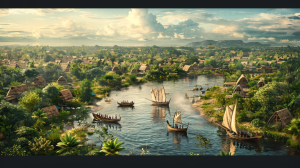The Maravi Kingdom, established in the 15th century in present-day Malawi, was a significant Bantu federation. Its influence expanded through trade and conquest. However, by the late 18th century, internal conflicts led to its fragmentation, giving rise to the Chewa and Nyanja states.
The once-thriving Maravi Kingdom, a land of fire and bravery, stretched across the boundaries of what is now known as Malawi, Zambia, and Mozambique. At its peak, the kingdom extended from the territories of the Tonga and Tumbuka to the south of the Lower Shire, encompassing the Luangwa and Zambezi river valleys in the west. The Mwale matriclan, with its leaders wielding the title of Kalonga, ruled from the bustling secular capital of Manthimba. Meanwhile, the spiritual heart of the Maravi was tended to by the patrilineal Banda clan, residing in the holy city of Mankhamba near Nthakataka and known for producing healers, sages, and skilled metallurgists.

Among the proud Maravi people of the Maravi Kingdom, men held sway over the ethereal realm of death and their ancestors through the powerful Nyau Society. Women, on the other hand, presided over life and rejuvenation. The Nyau Society staged magnificent performances, both with wooden and fleeting masks, during initiation ceremonies, funerals, and other significant events. These performances served as a bridge between the worlds of the living and the dead, allowing for a few days of harmonious interaction through the magic of song and dance. Each mask was governed by strict rules, dictating its appearance, movements, and melodies. All of these customs were fiercely guarded, shrouded in mystery and protected by the veil of secrecy.
After contact with Portuguese traders, the Maravi Kingdom saw a surge in trade, bringing exotic items such as Khami beads and Chinese porcelain to the Maravi kingdom. Despite its prosperity, the 19th century saw the decline of the Maravi as they were repeatedly attacked and raided by the neighbouring Yao, who captured and sold them as slaves on the markets of Kilwa and Zanzibar. It was not until the arrival of David Livingstone in 1859, and the subsequent arrival of Protestant missionaries, that Islam was introduced to the region through contact with Swahili slave traders. The region was then visited by a British consul in 1883, marking a new era for the once-great Maravi Kingdom.
As far back as the 1300s, a mass migration of related clans made its way into the stunning Lake Malawi region. Legends tell of their origin in the lush Congo Basin, near Lake Mweru, in an area that would later become part of the majestic Luba Kingdom. Over the centuries, these people journeyed on, until by the 1600s, the majority of them had finally settled in the rolling Shire River valley and surrounding areas to the west and southwest of Lake Malawi, including parts of modern-day Zambia and Mozambique. The first historical record of this powerful group, known as the Maravi, was made by the Portuguese traveler Gaspar Bocarro in 1616. The vivid descriptions by Father Manuel Barretto, a Jesuit priest, in the 1660s painted a picture of a thriving and economically strong confederation that spanned from the coast of Mozambique to the mainland, covering hundreds of kilometers between the Zambezi River and Quelimane Bay. And a record from the following century hinted that their western borders were near the magnificent Luangwa River, stretching all the way to the Dwangwa River in the north.
The Legacy of the Maravi Kingdom
Today, the name “Maravi” has become synonymous with the people of Malawi, Zambia, Mozambique, and Eastern Zimbabwe. Their rich cultural heritage is best exemplified in their language, the Chewa (also known as Nyanja, Chinyanja, or Chichewa), which is spoken throughout southern and central Malawi, as well as Zambia and Mozambique. This language, like the Maravi people themselves, is a testament to the enduring legacy of a once-great empire.
Related Posts
Sources
Newitt, M. D. D. “The Early History of the Maravi.” The Journal of African History 23, no. 2 (1982): 145–62. http://www.jstor.org/stable/182054.
Encyclopædia Britannica. “Maravi Confederacy.” Accessed February 12, 2023. https://www.britannica.com/topic/Maravi-Confederacy.





